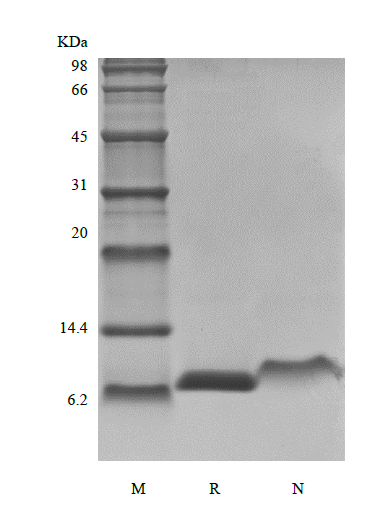- Synonyms
- Somatomedin C, IGF-I, IGF-IA, Mechano growth factor, MGF
- Source
- Escherichia coli.
- Molecular Weight
- Approximately 7.7 kDa, a single non-glycosylated polypeptide chain containing 70 amino acid residues.
- AA Sequence
- GPETLCGAEL VDALQFVCGP RGFYFNKPTG YGSSIRRAPQ TGIVDECCFR SCDLRRLEMY CAPLKPTKSA
- Purity
- > 97 % by SDS-PAGE and HPLC analyses.
- Biological Activity
-
Fully biologically active when compared to standard. The ED50 as determined by a cell proliferation assay using serum free human MCF-7 cells is less than 2 ng/ml, corresponding to a specific activity of > 5.0 × 105 IU/mg.
- Physical Appearance
- Sterile Filtered White lyophilized (freeze-dried) powder.
- Formulation
- Lyophilized from a 0.2 μm filtered concentrated solution in PBS, pH 7.4.
- Endotoxin
- Less than 1 EU/μg of rRtIGF-1 as determined by LAL method.
- Reconstitution
- We recommend that this vial be briefly centrifuged prior to opening to bring the contents to the bottom. Reconstitute in sterile distilled water or aqueous buffer containing 0.1 % BSA to a concentration of 0.1-1.0 mg/mL. Stock solutions should be apportioned into working aliquots and stored at ≤ -20 °C. Further dilutions should be made in appropriate buffered solutions.
- Stability & Storage
- Use a manual defrost freezer and avoid repeated freeze-thaw cycles.
- 12 months from date of receipt, -20 to -70 °C as supplied.
- 1 month, 2 to 8 °C under sterile conditions after reconstitution.
- 3 months, -20 to -70 °C under sterile conditions after reconstitution.
- Usage
- This material is offered by Shanghai PrimeGene Bio-Tech for research, laboratory or further evaluation purposes. NOT FOR HUMAN USE.
- SDS-PAGE

- Reference
- 1. Skottner A, Fryklund L, Hansson HA. 1986. Acta Paediatr Scand Suppl, 325: 107-11.
2. Bartlett WP, Li XS, Williams M. 1992. Brain Res Mol Brain Res, 12: 285-91.
3. Palmade F, Sechoy-Chambon O, Coquelet C, et al. 1994. Curr Eye Res, 13: 531-7.
4. Tennagels N, Hube-Magg C, Wirth A, et al. 1999. Biochem Biophys Res Commun, 260: 724-8.
5. Laron Z. 2004. Novartis Found Symp, 262: 56-77; discussion -83, 265-8.
6. Shiratsuchi I, Akagi Y, Kawahara A, et al. 2011. Anticancer Res, 31: 2541-5.
- Background
- The insulin-like growth factors (IGFs) belonged to the insulin gene family, are mitogenic polypeptide growth factors that stimulate the proliferation and survival of various cell types including muscle, bone, and cartilage tissue in vitro. The IGFs are similar by structure and function to insulin, but have a much higher growth-promoting activity than insulin. IGF-1 is produced primarily by the liver as an endocrine hormone as well as in target tissues in a paracrine/autocrine fashion. The production of IGF-1 is stimulated by growth hormone (GH) and can be retarded by undernutrition, growth hormone insensitivity, lack of growth hormone receptors, or failures of the downstream signaling pathway post GH receptor including SHP2 and STAT5B. Recombinant human IGF-1 are globular proteins containing 70 amino acids and 3 intra-molecular disulfide bonds. Mature rat IGF-1 shares 96 % a.a. sequence identity with human IGF-1 and exhibits cross-species activity.

 COA申请
COA申请
